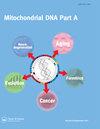真菌线粒体Nad5泛基因内含子景观
IF 0.6
4区 生物学
Q4 GENETICS & HEREDITY
引用次数: 7
摘要
摘要制备了真菌线粒体nad5基因内含子图谱。共检测了188种真菌,发现在nad5基因的29个内含子插入位点上有265个内含子。I类内含子有263个,II类内含子有2个。一个额外的II组内含子模块被确定嵌套在一个复合的I组内含子中。根据与RNA二级结构相关的特征,内含子可以分为不同的亚型,并且观察到内含子插入位点偏向于0期,它们似乎是特定于一种内含子类型的。内含子景观可以作为预测真菌mtDNA移动内含子位置的指导图,这些内含子是复合元件,包括核酶成分和在某些情况下编码归巢内切酶或逆转录酶的开放阅读框,所有这些在生物技术中都有应用。本文章由计算机程序翻译,如有差异,请以英文原文为准。
The fungal mitochondrial Nad5 pan-genic intron landscape
Abstract An intron landscape was prepared for the fungal mitochondrial nad5 gene. A hundred and eighty-eight fungal species were examined and a total of 265 introns were noted to be located in 29 intron insertion sites within the examined nad5 genes. Two hundred and sixty-three introns could be classified as group I types and two group II introns were noted. One additional group II intron module was identified nested within a composite group I intron. Based on features related to RNA secondary structures, introns can be classified into different subtypes and it was observed that intron insertion-sites are biased towards phase 0 and they appear to be specific to an intron type. Intron landscapes could be used as a guide map to predict the location of fungal mtDNA mobile introns, which are composite elements that include a ribozyme component and in some instances open reading frames encoding homing endonucleases or reverse transcriptases and all of these have applications in biotechnology.
求助全文
通过发布文献求助,成功后即可免费获取论文全文。
去求助
来源期刊

Mitochondrial Dna Part a
Biochemistry, Genetics and Molecular Biology-Genetics
CiteScore
3.00
自引率
0.00%
发文量
6
期刊介绍:
Mitochondrial DNA Part A publishes original high-quality manuscripts on physical, chemical, and biochemical aspects of mtDNA and proteins involved in mtDNA metabolism, and/or interactions. Manuscripts on cytosolic and extracellular mtDNA, and on dysfunction caused by alterations in mtDNA integrity as well as methodological papers detailing novel approaches for mtDNA manipulation in vitro and in vivo are welcome. Descriptive papers on DNA sequences from mitochondrial genomes, and also analytical papers in the areas of population genetics, phylogenetics and human evolution that use mitochondrial DNA as a source of evidence for studies will be considered for publication. The Journal also considers manuscripts that examine population genetic and systematic theory that specifically address the use of mitochondrial DNA sequences, as well as papers that discuss the utility of mitochondrial DNA information in medical studies and in human evolutionary biology.
 求助内容:
求助内容: 应助结果提醒方式:
应助结果提醒方式:


